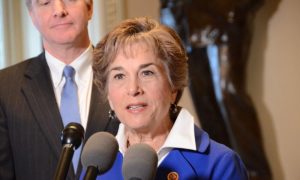
The U.S. Treasury just gave California more than half a billion dollars to fund broadband buildout. This money may help reduce the digital divide. It also might not. There’s really no way to know because the only public information about the grant is a press release that more closely resembles a flyer than an explanation of how the government is spending 540 million taxpayer dollars.
The money comes from the Capital Projects Fund, which is $10 billion allocated by the 2021 American Rescue Plan Act. The Act directs the U.S. Treasury to distribute these funds to states, territories, and tribal governments to subsidize new broadband networks.
Congress probably should never have directed the Treasury to lead the program. It’s not a grant-making agency, and Secretary Janet Yellen has bigger things to worry about, like the looming debt ceiling and the global economy.

Still, the Treasury has to do what the law tells it to do, and should be expected to follow some basic rules of good governance.
The program appears to lack even the most basic transparency. Treasury’s website lists a press release similar to California’s for each state award, and those others also provide almost no additional information. They do list “key state contacts,” but it’s typically an entire state agency. That’s just a hair more helpful than telling people to “call Congress” to learn more about government spending.
At a bare minimum, the public should be able to see the plan each state submitted to the Treasury and the final plan the agency approved. That might make it possible for researchers and watchdogs like the Government Accountability Office to evaluate the program — not only to see how well it worked, but to inform other broadband grant programs. Unfortunately, these plans do not appear to be available to the public.
Taxpayers should know how the states intend to spend the money once they have it because there are many ways to distribute the funds to those who would build networks. A long history of broadband subsidies and economic research provide lessons on these practices. It is important to know whether states are heeding or ignoring those lessons.

The answers make a huge difference. Research on the $4.5 billion broadband subsidy program under the Obama administration found that the grant assignment program was little better than randomly selecting winners from the pool of applications, while a more coherent competitive bidding process like a reverse auction would have stretched the money much further.
The little information we have is not encouraging. The grants appear to be spending far more per location than necessary, meaning the money is building less broadband than it could.
For example, California is getting $540 million to serve an expected 127,000 locations, or about $4,250 per location. That’s about the same as what the FCC estimated as the maximum it was willing to pay per location in California in the Rural Development Opportunities Fund in 2020. And because that money was distributed in an auction, the actual subsidy for gigabit connections came in lower than expected, at about $2,000 per location on average.
California does not seem to be an outlier in the Treasury program. Iowa is getting $152.2 million to serve an estimated 18,972 locations, or $8,022 per location. In the FCC’s RDOF subsidy auction, the FCC’s average reserve price for locations in Iowa was about $7,200 per location, and the auction results yielded a lower cost similar to in California — about $2,000 per location.
With the current opaque arrangement, we may never know whether the infrastructure money was well spent because we know little about how the states plan to distribute the money and how their efforts will be evaluated. To its credit, Treasury requires regular reporting on certain metrics by grant recipients. But there is no mention of any plans to invite independent analysis of how the money is spent and its cost-effectiveness.
This kind of transparency is important for more than a nod towards good governance of the $10 billion Capital Projects Fund. Treasury will soon be joined by the Department of Commerce when it releases another $42.5 billion to the states for essentially the same purpose. We should not accept a precedent of keeping the public in the dark on these infrastructure projects.
Scott Wallsten is president of the Technology Policy Institute. He is an economist with expertise in industrial organization and public policy, and his research focuses on competition, regulation, telecommunications, the economics of digitization, and technology policy. This piece is exclusive to Broadband Breakfast.
Broadband Breakfast accepts commentary from informed observers of the broadband scene. Please send pieces to commentary@breakfast.media. The views expressed in Expert Opinion pieces do not necessarily reflect the views of Broadband Breakfast and Breakfast Media LLC.
Originally posted on May 24, 2023 @ 2:30 am



